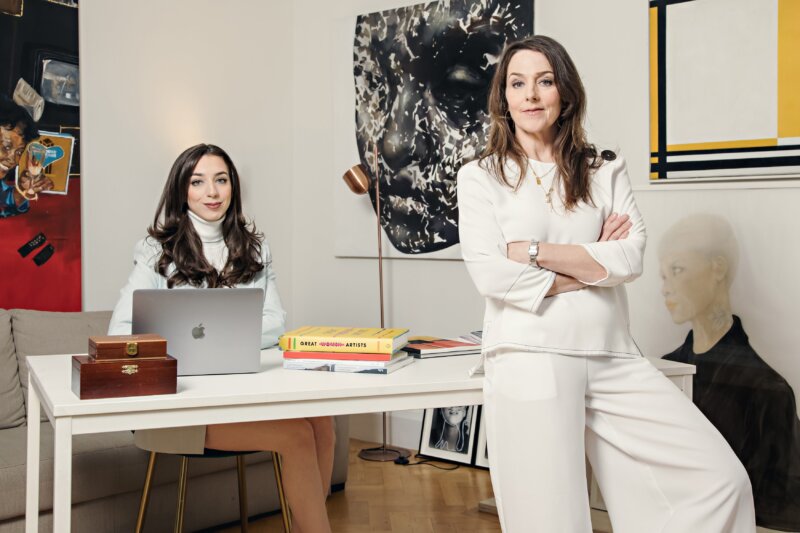In a progressively unstable world, investors are looking for financial return in alternative markets. Since the year 2000, the blue-chip art market has consistently outperformed the S&P. Increasingly, collectors are also turning to new and emerging artists, which hold a red-chip opportunity to buy fast and be first. With the emergence of global movements concerned with racial, gender and social equality, museums, auction houses and galleries have expanded their focus to catapult young artists onto the international scene.
Taking a gendered outlook, it is safe to say statistics reveal that investment in art by women is to this day under-represented in major museum collections all over the world. In 2019, whereas women filled approximately 30% of senior management roles across Europe and North America (Grant Thornton, Women in business report: building a blueprint for action, 2019), comparable levels of gallery representation for living female artists stands starkly lower at 13% (Bocart, Gertsberg, Pownall, Glass Ceilings in the Art Market, 2018). Now that we are cognisant of these facts, the art world – as well as the art buying public – are looking to reverse this trend. With a somewhat renewed post-pandemic vitality and enthusiasm, tides are slowly turning and a surge of interest in young and mid-career female artists makes today the time to start collecting.
As a female Founder with experience that spans across Investment Banking, Tech Start-Ups, Film Production, and Auction Houses, I am confidently advising our clients on how to navigate the art market, identify personal tastes, and make smart investments in art by women.
Here’s the Who, What, When, Where and Why guide for starting an art collection
1.Who are the artists to watch?
As a burgeoning collector, take your time to learn about artists, galleries, curators and advisors. Selecting artists whom you believe will be successful is both time consuming and overwhelming; however, with a more in depth look at the industry you will begin to put a picture together of the art and artists that you like. There is no such thing as good and bad taste so first and foremost, it is important to understand what sort of styles you identify with – abstract, figurative, sculpture, photography etc.
2.What platforms should I be researching?
Getting started can be achieved most easily by researching the many available online art sales platforms. Artsy and Artnet are excellent platforms to find artists who are attached to galleries, fairs and institutions. Another tip is to sign-up to mailing lists and attend events at galleries and museums with whom you identify. For those who are time strapped, Instagram is an efficient way to follow and stay up to date with the latest news from artists, exhibitions with galleries, and acquisitions by other collectors.
3.When in an artist’s career should I purchase a piece?
Whilst budget may affect your purchasing decisions, currently, emerging artists that are priced anywhere from £5,000 – £15,000 are at the most exciting part of their career. Due to the dynamic nature of the art markets and the wide variety of exciting new talent, even blue-chip collectors are expanding their investments into red-chip investment in painting and sculpture. When evaluating investment opportunities, it can be helpful to consider who represents an artist, where they are exhibiting, if they have an international presence, and whether high profile collectors and/or museums are collecting their pieces.
4.Where can I buy artwork from?
For artists who do not yet have representation, artwork can often be bought directly from their studio. However, after doing your research, you may find that the less risky investments are attached to artists who are amassing increasing amounts of interest in their works through group and solo exhibitions with established galleries. If this is the case now is the time to find yourself a friendly gallerist. Galleries are increasingly looking to widen their client base and are most happy to help the younger novice collector to hone their taste. The best art advisers and galleries will also be pleased to hear from you – send them an email and ask for their advice. Akin to the fashion brands you choose to shop for on the high street, making decisions about which galleries you collect from can be made based on your alignment with their ethos, style and customer service.
5.Why this piece?
The golden rule of purchasing any piece of artwork is to buy what you love! Even within the homes of serial and serious collectors, individual taste can unite a myriad of eclectic and seemingly opposing artworks. A lot like a wardrobe, statement pieces are key but I always advise collectors to purchase from artists that they believe to have career longevity.
Ensuring growth in your investment comes with knowing your market. Although there is no real way to evaluate trends with longevity, it is safe to say that aggregate commercial taste plays a large part in deciding which artists will last the course. Investing in artists who are represented by reputable galleries willing to ensure ongoing commercial and institutional patronage is always a sure fire hint at lasting potential.
Art is – and will remain – a popular alternative investment to the stock market, not only due to its a-symmetric nature with global recessions but also because of its ability to bring joy, cultural capital and aesthetic pleasure to each and every collector. At a time when social movements are taking hold and trend-setting collectors, galleries and institutions are listening, this moment in the art market presents a double whammy of opportunity; to not only invest in emerging female artists but invest in artists whose pieces are also being acquired by institutions and foundations who are aiming to restore an equilibrium to their major collections.
About the Author
Millie Jason Foster, Director of Gillian Jason Gallery.
Outgoing and articulate, with a gift for understanding, Millie guides the gallery’s agile collaborative attitude, working with the historical expertise established by her grandmother, while continuously approaching things through a dynamic start-up mindset. Her background in investment banking and tech start-ups informs her efficiency and problem-solving skills, underlined by an eye for detail which applies as much to artworks as it does to operations. A strategic thinker, she blends her relational approach with market-driven acumen, drawing excitement from emerging markets that, as she puts it, “should have been welcomed into the spotlight long ago and are incredibly important for local artists themselves”. For Millie, female, non-binary, and queer voices hold the power to drive change through the way people see, and in turn how they think. “The art world can’t remotely reflect the kind of equality society should be striving for until it includes artists of all colours and genders as equals rather than as additional considerations”.






